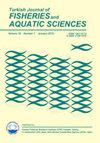赤耳帝幼虫消化道发育及消化酶活性研究
IF 1.7
4区 农林科学
Q3 FISHERIES
引用次数: 0
摘要
通过观察从孵化到孵化后40天(dph)的外部形态、组织学和酶活性变化,了解了长春藤幼虫消化道和相关器官的个体发育。L.lentjan消化系统的个体发育可分为三个主要阶段;从幼虫孵化到卵黄囊完全吸收的第一阶段(2 dph),第二阶段(3~15dph)即从外源性进食到胃腺形成,第三阶段(35 dph)直至变态完成。幽门盲肠在20dph后发育,完全由27dph形成。在外源性饲养开始前检测淀粉酶、脂肪酶、胰蛋白酶和糜蛋白酶的酶活性,从19日龄开始检测胃蛋白酶。因此,考虑到消化道的组织学和酶的发育,可以在19-20dph后断奶,同时形成幽门盲肠和产生胃蛋白酶,以获得更好的消化率,从而获得更好的生长和存活。本研究可作为了解其他经济重要海洋鱼类消化道发育和孵化成功的参考指南。本文章由计算机程序翻译,如有差异,请以英文原文为准。
Ontogenetic Development of Digestive Tract and Enzymes Activity in Hatchery-reared Pink Ear Emperor, Lethrinus lentjan Larvae
Ontogenetic development of the digestive tract and associated organs of Lethrinus lentjan larvae were learned by observing changes in external morphology, histology, and enzymatic changes from hatchling to 40-day post-hatching (dph). Ontogenetic development of the L. lentjan digestive system can be divided into three major stages; the first stage from hatching of larvae to complete absorption of yolk-sac, which ends on 2 dph, the second stage from 3 to 15 dph i.e., from exogenous feeding to the formation of the gastric gland and third stage till completion of metamorphosis (35 dph). Pyloric caeca were developed after 20 dph, which was formed entirely by 27 dph. Enzymatic activities of amylase, lipase, trypsin and chymotrypsin were detected before the onset of exogenous feeding and pepsin was detected from 19 dph onwards in L. lentjan. So considering both histology of digestive tract and enzyme development, weaning of L. lentjan larvae to artificial diet can be practiced after 19-20 dph coinciding with the formation of pyloric caeca and production of pepsin enzyme for better digestibility and consequently better growth and survival. The present study can be expended as a reference guide to understand the digestive tract development and successful hatchery rearing of other economically important marine fishes.
求助全文
通过发布文献求助,成功后即可免费获取论文全文。
去求助
来源期刊

Turkish Journal of Fisheries and Aquatic Sciences
FISHERIES-MARINE & FRESHWATER BIOLOGY
CiteScore
3.10
自引率
0.00%
发文量
43
审稿时长
3 months
期刊介绍:
Turkish Journal of Fisheries and Aquatic Sciences" (TrJFAS) is a refereed academic journal has been published by Central Fisheries Research Institute of Turkey and Japan International Cooperation Agency (JICA), and published in English.
It aims to address research and needs of all working and studying within the many varied areas of fisheries and aquatic sciences.
The Journal publishes English language original research papers, critical review articles, short communications and technical notes on applied or scientific research relevant to freshwater, brackish and marine environments.
TrJFAS was published biannually (April & November) between 2001 and 2009. A great number of manuscripts have been submitted to the journal for review from acceptance of the SCI index. Thereby, the journal has been published quarterly (March, June, September and December) from 2010 to 2017. The journal will be published monthly in 2018.
 求助内容:
求助内容: 应助结果提醒方式:
应助结果提醒方式:


